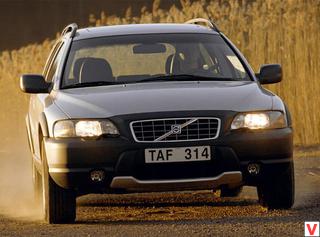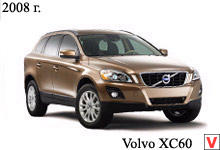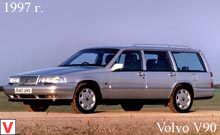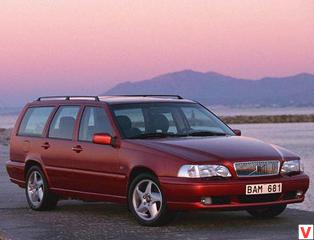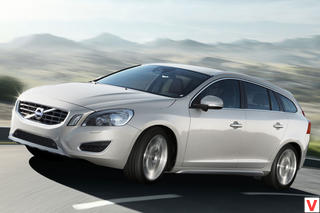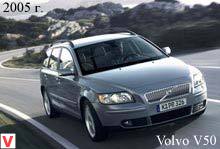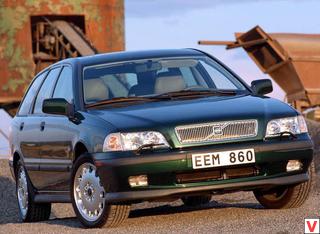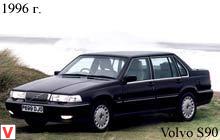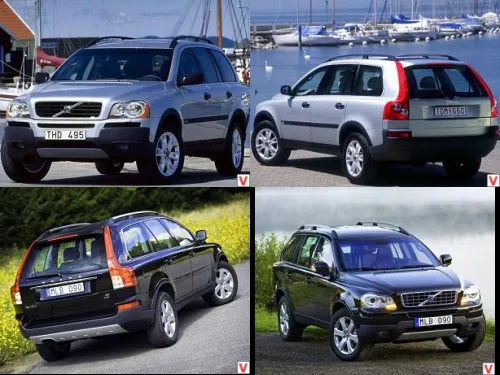
The Volvo XC90 debuted at the Detroit auto show in 2002. The Swedish company introduced a new four-wheel drive seven-seat "parquet" SUV. "Parquet", because to call a Volvo XC90 SUV is not entirely correct. For the "off-road" of the car they say: high ground clearance (218 mm), a powerful engine and one of the most progressive at the time of debut electronic all-wheel drive systems. Against the name of the XC90 SUV, said the lack of a mechanical inter-axle and cross-axle lock and, most importantly, the multiplier. The Volvo XC90 is built on the same platform as the Volvo S60, V70 and S80 cars. The length of the XC90 is 10 cm longer than that of the Volvo V70 station wagon.
Thanks to the different linings, the XC90 has an original body design that resembles an enlarged station wagon with high ground clearance. A distinctive feature of the Volvo XC90 is a truly spacious interior with a very thoughtful use of every centimeter of internal space. The car has a whole three rows of folding seats, which provides additional convenience when placing passengers and luggage. The driver and the front passenger in the Volvo XC90 share a huge panel, on which are located: radio, GSM phone, air conditioning and all the keys to control auxiliary functions.
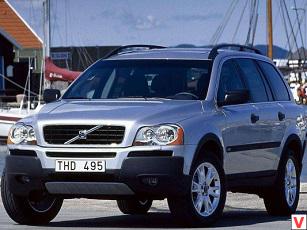
Decent dimensions and the optimum angle of inclination relative to the windshield made it possible not to flick with all the keys and buttons located on it and to make them equally accessible both to the driver and to the passenger. And the management of some systems - radio and telephone - is duplicated by buttons on the steering wheel of the Volvo XC90. And two more simple audio control unit located on the rear racks and equally accessible to passengers on the second and third rows of seats Volvo XC90. On the couch of the second row in the Volvo XC90 quietly placed three adults. It is designed as two full-size chairs, between which is located the third, narrower.
It can be transformed both in a child seat, and in a huge table-armrest. All three Volvo XC90 seats have a longitudinal adjustment and folding backrest. Volvo experts paid great attention to the transportation of children in the Volvo XC90. The center seat of the middle row moves forward on the sled, so that the child sits closer to the parents. In this case, you can remove the box-armrest, located between the front seats.
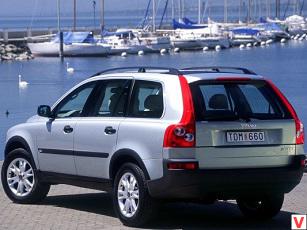
The third row in the Volvo XC90 is two full-size seats that have an original design. Without the slightest effort, the cushions are removed under the boot floor, and the backs are stacked in their place. As a result, we get a trunk with a completely flat floor and an impressive volume of 613 liters. And due to the fact that all the backs at the back of the Volvo XC90 are foldable, you can safely place a load of almost 3 meters in the cabin and go three-four together. And if without luggage - then seven people are arranged in the cabin XC90 with quite acceptable comfort.
The luggage compartment door is divided into two parts, providing the possibility of easy loading of baggage or playing the role of folding seats in long journeys. In the second row there is a child seat that can be transformed from the armrest. Holders for glasses, cans and various containers in the cabin dispersed a great many.
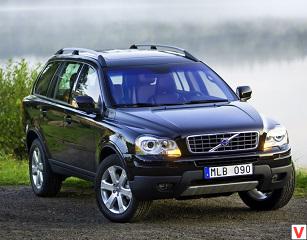
The XC90 is equipped with the most advanced automotive safety systems and is one of the safest cars in its class. In fact, there are so many safety features in this car that it has never been before in any other car. Several devices that provide stability in motion: Roll Stability Control (RSC), which works in conjunction with Dynamic Stability Traction Control (DSTC) and minimizes the possibility of a vehicle skidding on the road. Volvo XC90 - front-wheel drive car with the distribution of torque between the front and rear wheels in the ratio of 95: 5 percent, respectively.
But as soon as the front wheel of a car rolls around 1/7 of a turn, the electronics take over. The XC90 system instantly increases the load on the rear wheels, thus guaranteeing the best traction. And the Volvo XC90 TRACS traction control system, slowing down the wheel sticking, plays the role of locking the cross-wheel differentials, controlling the distribution of torque between the right and left wheels. The Volvo XC90 all-wheel drive system uses an oil-filled Haldex multi-plate clutch.
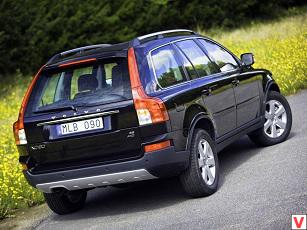
The electronic unit reads information about the speed of rotation of the wheels of the car, engine speed, load on it, the state of the brake system and in a split second can transfer torque to the rear wheels to eliminate slippage. In the process of braking Volvo XC90 all-wheel drive system is turned off so as not to interfere with ABS to do their work and maintain a straight-line movement. Frontal airbags and side curtain airbags ensure the safety of all passengers on the XC90. There are sensors that track the behavior of the car in the horizontal plane, but there are also sensors that monitor the roll.
When the computer receives a signal that the rate of increase of the roll angle has reached the threshold, the system regards this as a risk of overturning and at the same time reducing the fuel supply gives the command to slow down the loaded (external to the center of rotation) wheels - first of all it refers to the front wheel. As a result, the car will go on a flatter trajectory, the risk of overturning will decrease. In addition to electronics, there are also purely design safety solutions. The Volvo XC90 is extremely durable.
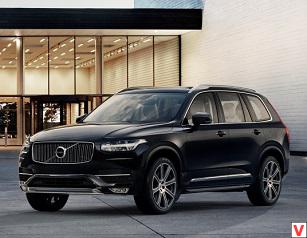
The roof contains elements of boron-containing steel, which is four to five times stronger than conventional steel grades. Racks - from a special alloy, high strength, many times greater than the strength commonly used in the construction of cars. Seat belts will not allow the reminder system to be forgotten; it will give a signal until passengers are fastened.
Inline 6-cylinder petrol engine of 2.9 liters with twin turbocharger. With this 6-cylinder engine and 4-speed gearbox Geartronic Volvo XC90 develops 100 km / h in just 9.3 seconds, and the top speed is 210 km / h. Inline 5-cylinder 2.5-liter gasoline engine with low pressure turbo supercharger. The power of this engine is 210 hp. This engine is equipped with a 5-speed gearbox Geartronic.
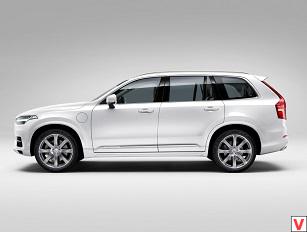
Volvo XC90 with this engine develops 100 km / h in 9.9 seconds, top speed - 210 km / h. Inline 5-cylinder 2.4-liter turbo diesel with common rail fuel supply system. This engine develops power in 163 hp The diesel engine is installed with a 5-speed gearbox Geartronic. Such a modification of the XC90 develops 100 km / h in 12.3 seconds, and the top speed is 185 km / h. Since its debut, the XC90 has sold over 600,000 copies. Since then, the car has been repeatedly updated, but all the changes experienced by him were insignificant.
The long-awaited transition to a new generation took place on August 26, 2014, when the first presentation of the second generation XC90 for automotive journalists and a narrow circle of technical experts was held in Stockholm. The official world premiere of the second generation Volvo XC90 was held in October 2014 at the Paris Motor Show. Of course, after so many years of production, the model was waiting for a global update. The basis of the SUV formed a completely new scalable and versatile platform SPA (Scalable Product Architecture). Volvo representatives say that it took the company five and a half years to develop this platform.
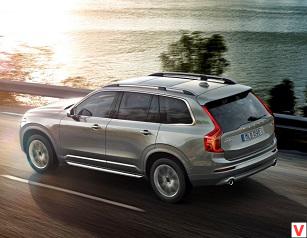
XC90 2015 was created almost from scratch - more than 90% of parts and assemblies are new. In the power frame of the body of the second generation Volvo XC90 are widely used aluminum, ordinary steel, steel of high, ultra-high, extra-high and ultra-high strength. Such a modern and high-tech composition of materials provides torsional rigidity of the body - 24,000 Nm / hail, despite the fact that the body structure itself weighs only 400 kg.
The overall length of the XC 90 in the new body increased to 4,950 mm (+ 127), and the size of the wheelbase added 143 millimeters to 2,984. The width of the model increased to 2,008 mm (+ 73), and the height was reduced to 1,775 (- 9 ). A few words about the suspension. The front and rear of the new aluminum suspension with steel subframes are used. The front of the car rests on an independent suspension with double wishbones.
A multi-link design is used at the back, complemented by a transverse spring made of composite materials. As an option, the suspension of the crossover can be replaced with a pneumatic one with the function of automatically changing the clearance depending on road conditions and the chosen driving mode. Reinforced disc brakes are used on all wheels, with ventilated front discs.
Rack and pinion steering mechanism supplemented by an electro-hydraulic amplifier with variable force. The design of the model is made in the new corporate style of the company, developed by Thomas Ingenlat. The exterior is distinguished by simple and concise lines, noble forms. Designers managed to correctly and accurately place accents on the car body, forcing to forget about the dimensions.
As a result, the XC90 2015, despite its gigantic size, looks easy, dynamic and sporty. The revised contours of the body, coupled with the new bumper and well-thought-out hood stamps, improved aerodynamics, bringing the drag coefficient to 0.30 Cx. In the front of the body, new headlights with a T-shaped LED insert, which was called the “Thor's Hammer”, catch in the eyes. The neat and stylish false radiator grille is decorated with an updated Volvo emblem with a diagonal beam, while the angle of inclination of the bar coincides with the angle of the spear of the god of Mars on the logo.
The side of the car is characterized by powerful dilators of wheel arches in which low-profile tires 275 / 40R21 are placed, dressed on light-alloy wheels with 8 spokes (it is possible even to install disks R22). The back of the body received the original ceiling lighting fixtures with LED filling, even more original tailgate door with a large glass area and a spoiler, as well as a strict and stylish bumper with tailpipes integrated into the surface of the trapezium. The interior of the XC90 2015 has become the most luxurious in the entire history of the brand.
The interior uses high-quality natural leather (Scotland), natural wood (birch from the north of Sweden), metal decorative elements, and the gear selector in the top hybrid version is made by hand from Orrefors crystal. The center console is almost devoid of buttons. All functions are controlled by a 9.5-inch color touch screen with a Sensus interface that supports voice commands, as well as integration with Apple smartphones and based on Android OS. The instrument panel is also fully electronic. The manufacturer managed to achieve a significant increase in free space on all rows of seats, which can be two or three, depending on the version (5 or 7 seats).
Increase the free space for the feet of passengers, allowed the new ergonomic chairs with thinner backs. True, the third row of seats is designed for children or people up to 170 cm tall. Comfort front seats, which are included in the basic equipment, have adjustments of the sidewalls, the length of the pillow and lumbar support, and for an extra charge they can be equipped with ventilation and massage functions. The audio system for the car has developed a British company Bowers & Wilkins.
It is available in three versions: a basic with six speakers and a 52-watt amplifier, intermediate with 12 speakers and a 224-watt amplifier, as well as a top amplifier - with a 12-channel HARMAN amplifier with a capacity of 1,400 watts, a combination of 19 speakers and integrated into the body structure air-cooled subwoofer. The list of basic equipment includes LED daytime running lights, fog lights, LED taillights, full electric, heated front seats, seats with energy-absorbing frame, four-zone climate control, seat belt pretensioners on all rows of seats, at least 6 airbags, road recognition system signs, circular parking sensors and more.
Among the options is an advanced climate control with independent control for the third-row seats, all-round cameras, a projection display on the windshield, a Wi-Fi access point, a system for recognizing pedestrians and cyclists in city streets. Volvo XC90 2015 received the most advanced security systems. For example, the car has the functions of automatic braking when passing through the intersection (Auto brake at intersections) and preventing the exit from the road (Run-off road protection).
Also available for the SUV system is fully autonomous parking without the driver, the ability to recognize objects in the dark and the system Queue Assist, able to provide movement for moving ahead of the car in stop-and-go mode (completely repeats the maneuvers). If there is a risk of a rear impact, belt tensioners are automatically activated on all rows of seats and brake lights start flashing more actively. With the rear seats spread out, the boot capacity is about 450 liters. The maximum cargo volume of the luggage compartment with the third and second row seats folded is 1899 liters, while the trunk length is 2040 mm.
The tailgate with an electric drive, and if necessary, can be opened with a wave of the leg under the rear bumper. The second generation has received a line of brand new petrol and diesel engines from the Drive-E family. All of them have 4 in-line cylinders with a cumulative displacement of 2.0 liters, direct fuel injection, 16-valve timing DOHC type and turbocharging. The diesel engine D5, characterized by the presence of a completely new system of individual control of fuel injection i-Art with feedback, will be basic in the Russian market, allowing to optimize fuel consumption much more efficiently than the common Common Rail system.
Motor D5 is able to develop up to 225 hp power, as well as about 470 Nm of torque. At the same time consuming just 4.9 liters per 100 kilometers. The weaker 190-strong version of the diesel engine (D4) will not reach Russia and will be available only in European countries. Petrol engines are also two. The role of the younger performs T5 power of 249 hp and 350 Nm of torque.
The T6 engine, additionally equipped with a mechanical compressor, became the flagship gasoline engine. Its upper limit of power is marked 320 hp, and the peak torque is 400 Nm. The most powerful gasoline engine provides the crossover with acceleration dynamics up to 100 km / h in 6.9 seconds and a maximum speed of 230 km, with an average fuel consumption of 7.7 liters. At the top of the range is a hybrid version of the T8 TwinEngine, which includes a 2.0-liter 320-horsepower gasoline “four” Drive-E with direct fuel injection, a compressor and a turbocharger, as well as an 87 hp electric motor. (240 Nm), transmitting the traction on the rear axle.
The total return of such an installation is 376 hp and 640 Nm of torque. At the same time, the Volvo XC90 Plug-in-Hybrid is exclusively capable of covering about 43 kilometers. Acceleration to hundreds of such versions takes 5.6 seconds, and the average consumption in the combined cycle is declared at the level of 2.7 l / 100 km. We add that all power units work in tandem with the unopposed 8-band "automatic". Front-wheel drive is only possible for the basic version of the Volvo XC90 D4 (full charge), all other versions are equipped with all-wheel drive, where the fifth-generation Haldex clutch is responsible for connecting the rear wheels.
The second-generation Volvo XC90 is stylish, expensive, beautiful in appearance, with a chic interior, premium finishing materials and rich equipment, modern technical stuffing.
